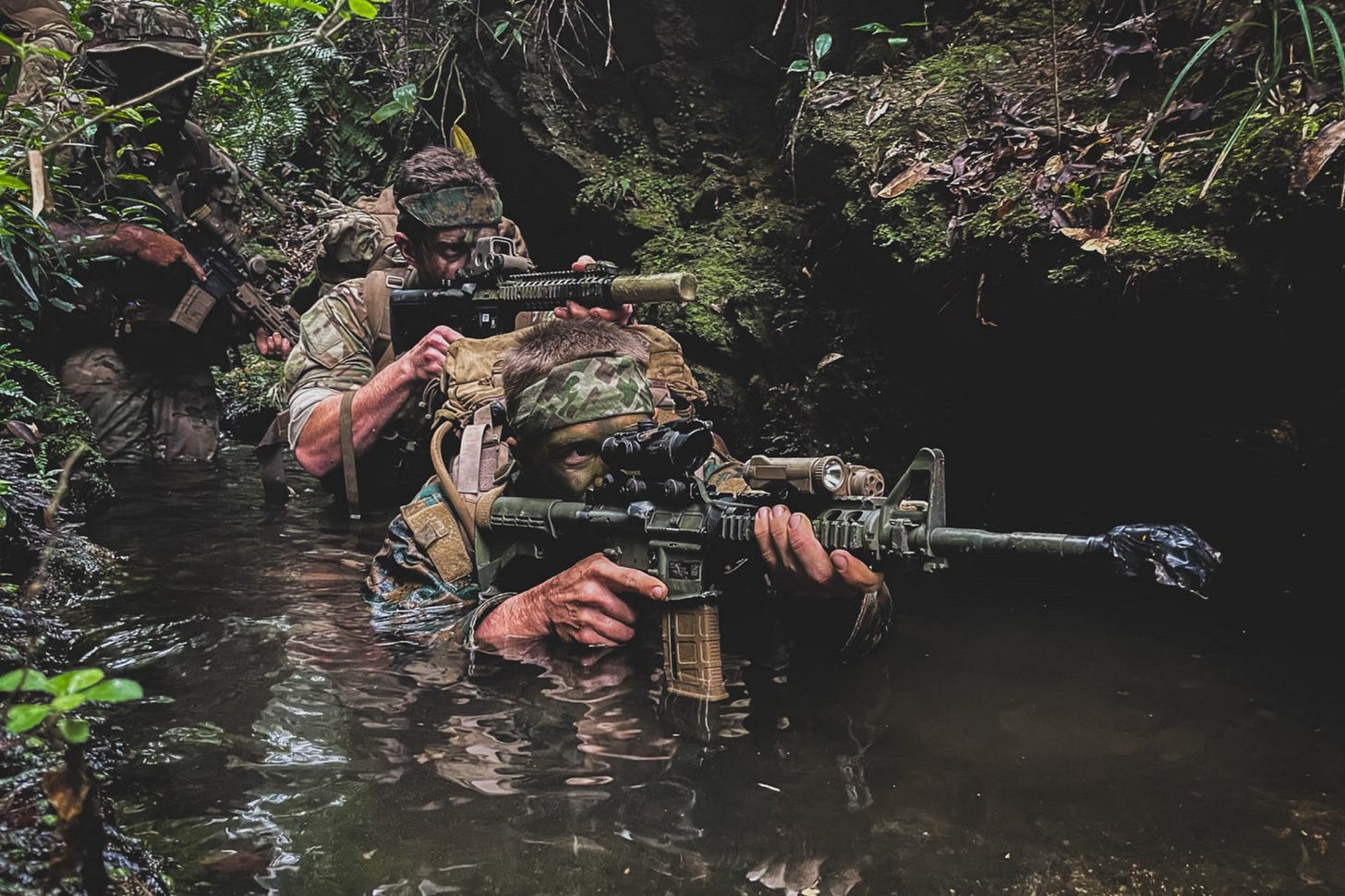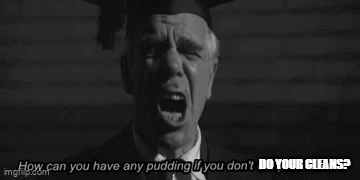Z.09: There is no max score

Lots of soldiers want to know just how fit they should be. In my Where Data Meets Gains series, I firmly planted my flag on readiness as the best measure.
The real test comes when you haven’t rested up for a week or spent the whole day prior hydrating. It comes abruptly, when you aren’t ready and often when you didn’t want it to. It will come when you are tired and sore, and then it will turn around and test you again right after. And again.
The real test is simple. There’s just one question, and it is pass-fail: ‘Are you ready?’
Some people struggle to live with the ambiguity being ready demands. “Ready for what?’" It’s probably unsurprising I’m comfortable in that space, since the ability to handle uncertainty is just one of the key characteristics SFAS selects for. But being a Green Beret isn’t for everyone; there are other measures out there to use.
Mike Kloepper, the Brigade Tactical Officer at West Point, recently weighed in with his measure in a post on his substack.
A Cadet asked me a few days ago, “Sir, what’s a good run time in the actual Army?”
So, here’s the deal….
The 2-mile run test isn’t about running 2 miles. It’s not about running at all.
The 2-mile run test is actually about measuring VO2 Max.
VO2 Max is your body's ability to perform endurance activities and is a predictor of athletic performance. It's also linked to overall health and longevity.
Combat is an endurance activity that requires athletic performance.
So, the question isn’t, “What’s a good run time?”
The question should be, “In a contest of violence, suffering, and Will Power, how fit and tough do you want to be?” What’s good enough when it’s all on the line?
I think overall both Mike and my definitions largely converge. We also both think all soldiers should be fit, not just the combat arms ones. But we diverge on how to measure it.
I’m going to try to avoid raising issue with things Mike didn’t say, because he didn’t say a lot. He makes little to no mention of the other ACFT events, nor the different aspects of fitness they test. I don’t know Mike’s opinion on what a good deadlift score is. He never brings it up. But combat demands a minimum of raw power. History has plenty of anecdotes like Corporal Seyit’s when the ability to pick up and carry heavy things was the decisive difference between winning and losing.1
I also don’t know what Mike thinks about the way the sprint-drag-carry tests your anaerobic capacity and recovery. As a reminder, anaerobic is when you blow through your VO2Max and tax your body to its limit. The army’s study on the demands of combat, the one that led to the creation of the ACFT, found ‘intense sudden anaerobic activity’ and the ‘ability to rapidly reduce heart rate to either engage or make decisions’ were key. Indeed, the army found there was a persistent ‘requirement for continuous maximum effort followed by engagement and/or decision’. Mike didn’t give us his thoughts on anaerobic fitness nor a leader’s ability to regain the ability to think.
All we’ve got is his faith in VO2Max and the maximum run times on the two-mile run test as his metric.
Where Mike and I Diverge
Mike starts off with the claim that ‘We are getting slower’ and includes a snapshot of historical maximum test standards (100 points).
But that claim is not entirely true. Not everyone’s maximum scores have gotten slower. Here’s what the full data really says.
Now there’s a lot of data in this chart, but I’m going to come back to it. First, take a closer look at the lower left portion of the chart:
The men’s maximum scores have slowed down in all but two age brackets (42-46 & 62+), by about :14 seconds on average. But the women’s maximum scores have gotten faster for every age bracket, from as little as :07 seconds (17-21) to as much as 2:42 (62+). I think there’s good reasons for this change, but we owe credit where credit is due: women are having to run faster to max the two-mile run in the ACFT than they did in the old test.
Mike next highlights that ‘we’re getting bigger’.
While I don’t dispute America’s declining fitness, I do take issue with the data Mike’s leveraging. He didn’t include a link to the chart, but a google image search turned up this study In the New England Journal of Medicine. The infographic is based off BMI data, which as I’ve addressed elsewhere, is a lazy and inaccurate way to calculate fitness.
Mike concludes, ‘We are slowly moving the goal posts of excellence’. He’s not entirely wrong. We did after all make it a little easier to max the run for men and objectively harder for women. But the principal reason the max scores changed isn’t because we got obese, it’s because the test got harder. Under the old three-event APFT, soldiers were taxed less. Neither the push-ups nor the sit-ups came close to a soldiers VO2Max, coming no where near anaerobic heart rates. But even more importantly, soldiers were given noticeably more rest:
‘Soldiers are allowed a minimum of 10 minutes and a maximum of 20 minutes rest between events.’ - FM 7-22
Meanwhile rest in the ACFT is restricted to just a handful of minutes between the first several events. While soldiers do get a longer rest before the final two-mile run, the old minimum is now the maximum reprieve.
‘After the Plank event, there is a programmed rest 10 minutes before starting the 2-mile Run’ - ATP 7-22.1
And more importantly, this comes on the heels of the sprint-drag-carry, which pushes most soldiers through their VO2Max and into an anaerobic heart rate. The plank buys some time for recovery, but there’s typically still lactic acid coursing through your veins when you start that run. That’s what those additional :14 seconds are based on.
Why VO2Max Isn’t The Only Measurement
VO2Max is one good measurement to add to your overall self-assessment. But it’s not the only one. This is part of why our fitness test has five events — more on that change later. But you don’t even have to run two miles to test your VO2Max. Writing back in 2018, Zach Griffiths highlighted how a shuttle run can provide an accurate assessment:
With that in mind, a more field-expedient method of predicting VO2 max and aerobic capacity would be the use of the twenty-meter multistage shuttle run test, otherwise known as the “beep test.” Multiple studies dating back to 1989 have confirmed the efficacy of using the twenty-meter shuttle run as a predictor of VO2 max and aerobic capacity.2
Any unit deployed anywhere can find a flat 20m stretch somewhere.
But I argue VO2Max isn’t enough of an assessment on its own. The army agrees. We used the two-mile run for decades as a yardstick and it was found wanting.
Let’s look at an example. Cyclist Oskar Svendsen is regarded as the world record holder for VO2Max with his 96.7 milliliter-per-kilogram-per-minute set back in 2012. That is a truly impressive feat of athletic ability. But at 6’4” and just 167.5 pounds, his VO2Max begs the question: What would he do with 18 to 45 kilos of kit on him? Oskar is dangerously close to falling below the minimum weight to even serve in the army for his height. He’s easily 30 pounds under the mass we’d expect a soldier of his height to have.
Think of the world champion marathoners. They have certainly got incredible VO2Maxes which enables them to cruise through each kilometer at a sub 3:00 pace. They can finish a two-mile in just over nine minutes, obliterating even the pre-1998 max standard. But then look at their calves. Look at their thighs. Look at their shoulders. They would crumble under kit.
This is part of why RAND’s study found the deadlift was a strong predictor of not just ACFT success, but also passing other combat focused skills.
Mike only gives us his thoughts on the two-mile and VO2Max. He doesn’t tell soldiers how to assess combat related tasks. He doesn’t ask, ‘How fast should my sprint-drag-carry be? What about if I fall down (twice) and have to chase down the kettlebells I yardsaled and keep going? What’s an acceptable time then? What’s a good way to test my ability to get hurt, to get thrown for a loop, to get hit and have to keep going?'
VO2Max doesn’t answer those questions.
And while Mike doesn’t say running is the way to train fitness, his post can leave soldiers with that impression. But running isn’t always the best use of your training time and can lead to repetitive use injuries. There are faster ways to improve your VO2Max, ones that will also improve your anaerobic capacity. High Intensity weight training will not only improve your overall strength and help protect against injuries, it can also improve your run time.
Why Max Scores Aren’t The Measurement Either
Max scores encourage a plateau mindset. This is not unique to fitness and was one of the challenges the USMC focused on with their new JMAP marksmanship program.3 Max scores actually discourage real achievement, because they disincentive pushing past them. Max scores are why you see soldiers stop and get up as soon as they hit them, rather than finding out what they can really do.
They also breed a ‘max score’ identity that can both lower standards and disincentivize growth. The change in 1998 from a 11:54 to a 13:00 maximum score two-mile run time was largely driven by the desire to have more 300 APFT ‘leaders’ across the army. That stubborn ‘I’m a 300 soldier’ attitude is a large part of why it’s 2025 and we still don’t have an ACFT ready army.
Some of the best assessments I’ve done involve minimum standards, but no maximum. These ensure everyone can perform at the required ability to do their job, while also encouraging soldiers to pursue greatness where they can. One example is the UBRR, where you can earn 100 points for achieving the minimum in each of the nine events and then receive supplemental points for exceeding the standard.4 A passing score is 900 points, but soldiers are encouraged to exceed that standard and can even make up for failing an event by excelling in others. I’ve served with some incredible soldiers whose UBRR score would be a phenomenal SAT score.
Thanks to Rob Vaccarelli and the guys in C/1-1, I’ve also adopted an even more challenging version of the UBRR where the events start every three minutes. In addition to dramatically reducing rest, it puts you into a tough position of deciding whether those additional reps are worth the fleeting break you need before you start the next challenge. It engages your decision making while under duress and forces you to be judicious in where you expend your energy over a sustained burn.
The Minimum Run Times Are Our Real Problem
While Mike and I diverge on VO2Max and his focus on max scores, we are in violent agreement on the other end of the ACFT scale.
I would worry deeply about a young officer who is having trouble generating the minimum time of 22 minutes
Let’s go back to that chart and take a look at the right side this time.
See that dashed line with gold dots on it? That’s the minimum ‘gold’ standard from the 2019 version of the ACFT — back when we had leg tucks.5 Currently, the minimum scores for all ages and genders is even slower than the 2019 minimum standard.
I care way more about the minimum standards than I do the maximum ones. This is because the real answer to that cadet’s question isn’t what his run time should be, it’s what his team’s run time is.
Combat is not a solo sport. Your best run time won’t help you much in combat, but your team’s weakest run time could get you all killed. One thing you learn in ground fighting is the guy whose buddy shows up first is the winner.
The last ruck march I did in the infantry before I left for SFAS still sticks with me. I’d just finished a week of training in the field and coincidentally my time as an XO of an infantry RSTA company.6 As we set off on a 12 mile ruck back to the headquarters it became clear pretty quickly that not everyone in the company was going to make it. At the first water break, the company commander berated the formation for how slow they were moving and then took off again with just one other platoon leader in his wake.
The remaining platoon leader — our company only had two scout-sniper platoons — took stock of the formation and set out at a new pace, with the first sergeant in trail. We lost a couple more, and that was ok. It was training and people have to be allowed to fail. But the junior lieutenant understood how to strike the balance between keeping enough of his formation to be able to execute his combat mission and the need to send a clear signal that the company needed to step up its overall fitness.
When we trudged into the HQ, we were easily an hour behind the commander and the other lieutenant. They were quick to gloat. I just rolled my eyes and commended the young LT. ‘I can’t think of a recce mission I can complete with just a captain and a lieutenant. Nice work.’
I have a lot of concerns about our ACFT minimums. It’s perfectly normal these days to see someone walking on the run, confident they can still pass the standard. I don’t think every soldier needs to be a gazelle that can run a 13:30. But I do think they need to be capable of jogging two miles without walking.
Meet the AFT (Standards TBD)
Which is why I’m stoked to see the army has another prime opportunity to get this right. It looks like the army listened to the RAND study, because the first thing they did was get rid of the overhead yeet. They’ve also announced a list of 21 MOSs that will have new gender-neutral standards.
Back in January I did a deeper dive on the higher standards the RAND study recommended, but we’ll have to wait to see which ones the army releases in the coming months. I’ll admit, I don’t know what ‘age normed’ means, but I’m not excited by it. If the rigors of combat don’t discriminate on gender, then they damn well don’t take age into account either.
The AFT represents a great chance to eliminate max scores and instead reexamine where we put the ‘black’ and ‘silver’ cut off lines. Regular Downrange Data readers know me well enough to know I’ll be following up with another post as soon as the new standards are published.
Until then, just because the stupid yeet is gone, doesn’t mean you don’t need explosive power. Best get back to those barbells.
Seyit was doing Multi-Domain Operations back when they were hard.
Zach also beat me to my sprint-clean-carry idea. Feel free to share Zach’s six + year old article with anyone still claiming they need more time to get ready for the ACFT.
Joint Marksmanship Assessment Package. The marines of Weapons Training Battalion in Quantico published an article in the Marine Corps Gazette, and did a podcast interview with War on the Rocks on the subject. Both are well worth a read / listen.
Upper Body Round Robin. A fitness test many SOF units use. The majority of the movements are focused on core and muscular strength, though there is a five-mile run at the end, because army gotta army.
No one has ever explained to me why the ‘gold standard’ was the weakest one.
Reconnaissance, Surveillance, and Target Acquisition, these units have a loose lineage with Long Range Recce Patrols (LRRP) and Long-Range Surveillance (LRS) units. The LRS and LRRP are gone, and last I heard the RSTAs weren’t far behind them.










